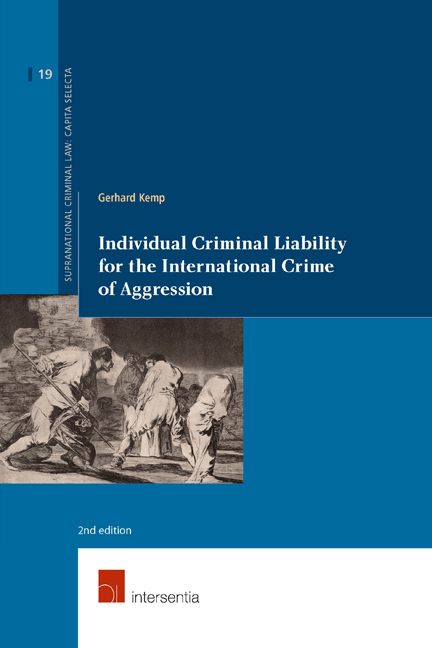Book contents
- Frontmatter
- Foreword to the Second Edition
- Foreword to the First Edition
- Preface
- Contents
- List of Abbreviations
- PART I INTRODUCTION AND FRAMEWORK OF ANALYSIS
- PART II COLLECTIVE SECURITY AND THE JUS CONTRA BELLUM
- PART III THE CRIMINALISATION OF AGGRESSION
- Chapter III From Jus Contra Bellum to the Criminalisation of Aggression
- Chapter IV The ‘Legacy of Nuremberg’: Establishing Individual Criminal Liability for the Crime of Aggression
- PART IV THE INTERNATIONAL CRIMINAL COURT AND THE CRIME OF AGGRESSION
- PART V NATIONAL AND REGIONAL CRIMINALISATION AND PROSECUTION OF THE CRIME OF AGGRESSION
- PART VI ANNEXES
Chapter IV - The ‘Legacy of Nuremberg’: Establishing Individual Criminal Liability for the Crime of Aggression
from PART III - THE CRIMINALISATION OF AGGRESSION
Published online by Cambridge University Press: 12 December 2017
- Frontmatter
- Foreword to the Second Edition
- Foreword to the First Edition
- Preface
- Contents
- List of Abbreviations
- PART I INTRODUCTION AND FRAMEWORK OF ANALYSIS
- PART II COLLECTIVE SECURITY AND THE JUS CONTRA BELLUM
- PART III THE CRIMINALISATION OF AGGRESSION
- Chapter III From Jus Contra Bellum to the Criminalisation of Aggression
- Chapter IV The ‘Legacy of Nuremberg’: Establishing Individual Criminal Liability for the Crime of Aggression
- PART IV THE INTERNATIONAL CRIMINAL COURT AND THE CRIME OF AGGRESSION
- PART V NATIONAL AND REGIONAL CRIMINALISATION AND PROSECUTION OF THE CRIME OF AGGRESSION
- PART VI ANNEXES
Summary
INTRODUCTION
In Chapter III above it was observed that to a certain extent the trials at Nuremberg and Tokyo were remarkable historical events (and, to an important extent, exercises in history writing). It was also noted that these trials represent the concretisation of the ideal to end impunity for international crimes. However, as far as individual criminal liability for aggression is concerned, the sometimes awkward jurisprudential positions concerning questions of legality (nullum crimen, nulla poena sine lege), the scope and ambit of the concept of aggression, the issue of conspiracy, and other factors impacting on the aggression debate were not definitively solved at Nuremberg and Tokyo. As William Schabas observed:
‘[It] is certainly striking to observe that the uncertainty about the role of aggression within the overall system of international criminal law is not only characteristic of the debate that immediately preceded Nuremberg, but it is also manifested in the approach to the issue in the decades that were to follow the landmark trial. The failure of the United Nations War Crimes Commission to even take a position on whether or not aggressive war should be a crime seems remarkably like the hesitations at the Rome Conference [on the International Criminal Court], more than half a century later.’
Indeed, after Nuremberg, Tokyo and the subsequent trials under Control Council Law No 10 in Germany, no serious attempts were made to prosecute individuals for the crime of aggression in the post-Second World War era. The aim of this chapter is to analyse the reasons for this state of affairs. First, the efforts of the United Nations to consolidate and preserve the legal legacy of Nuremberg will be examined. Second, this ‘Legacy of Nuremberg’ will be analysed contextually, with reference to some of the key developments in international criminal law in the post-Second World War period. Finally, some preliminary conclusions regarding the impact of the legacy of Nuremberg on the establishment of the permanent International Criminal Court will be identified.
- Type
- Chapter
- Information
- Publisher: IntersentiaPrint publication year: 2015



